Museum of Fine Arts, Boston
 | |
 Location within Boston | |
| Established | 1870 |
|---|---|
| Location |
465 Huntington Avenue Boston, MA 02115 |
| Coordinates | 42°20′21″N 71°05′39″W / 42.339167°N 71.094167°W |
| Type | Art museum |
| Visitors | 1,227,163 (2015) |
| Director | Matthew Teitelbaum |
| Architect | Guy Lowell |
| Public transit access | |
| Website | mfa.org |
The Museum of Fine Arts (or MFA) in Boston, Massachusetts, is the fourth largest museum in the United States. It contains more than 450,000 works of art, making it one of the most comprehensive collections in the Americas. With more than one million visitors a year,[1] it is the 55th most-visited art museum in the world as of 2014.
Founded in 1870, the museum moved to its current location in 1909. The museum is affiliated with the Tufts School of the Museum of Fine Arts.
History
1870–1907
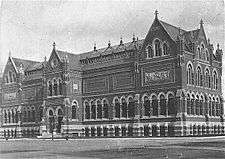
The Museum of Fine Arts was founded in 1870 and opened in 1876, with most of its initial collection taken from the Boston Athenæum Art Gallery. Francis Davis Millet, a local artist, was instrumental in starting the Art School affiliated with the museum, and in appointing Emil Otto Grundmann as its first director.[2] The museum was originally located in a highly ornamented brick Gothic Revival building in Copley Square designed by John Hubbard Sturgis and Charles Brigham which was noted for its massed architectural terracotta in an American building. It was built almost entirely of red brick and terracotta with a small amount of stone in its base. The brick was produced by the Peerless Brick Company of Philadelphia and the terracotta was imported from England.[3]
1907–2008
In 1907, plans were laid to build a new home for the museum on Huntington Avenue in Boston's Fenway-Kenmore neighborhood near the renowned Isabella Stewart Gardner Museum. Museum trustees decided to hire architect Guy Lowell to create a design for a museum so that could be built in stages as funding was obtained for each phase. Two years later, the first section of Lowell’s neoclassical design was completed. It featured a 500-foot (150 m) façade of granite and a grand rotunda. The museum moved to its new location later that year; the Copley Square Hotel eventually would replace the old building.
The second phase of construction built a wing along the The Fens to house paintings galleries. It was funded entirely by Maria Antoinette Evans Hunt, the wife of wealthy business magnate Robert Dawson Evans, and opened in 1915. From 1916 through 1925, the noted artist John Singer Sargent painted the frescoes that adorn the rotunda and the associated colonnades. Numerous additions enlarged the building throughout the years, including the Decorative Arts wing in 1928 (again enlarged in 1968) and the Norma Jean Calderwood Garden Court and Terrace in 1997. The West Wing, designed by I. M. Pei, opened in 1981, and was renamed the Linde Family Wing for Contemporary Art in 2008. This wing now houses the museum's cafe, restaurant, and gift shop as well as a special exhibition space.[4]
2008–present
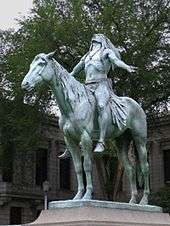

In the mid-2000s, the museum launched a major effort to renovate and expand its facilities. In a seven-year fundraising campaign between 2001 and 2008 for a new wing, the endowment, and operating expenses, the museum managed to total over $500 million, in addition to acquiring over $160 million worth of art.[5] During the global financial crisis between 2007 and 2012, the museum's budget was trimmed by $1.5 million and the museum increased revenues by conducting traveling exhibitions, which included a loan exhibition sent to the for-profit Bellagio in Las Vegas in exchange for $1 million. In 2011, Moody's Investors Service calculated that the museum had over $180 million in outstanding debt. However, the agency cited growing attendance, a large endowment, and positive cash flow as reasons to believe that the museum's finances would become stable in the near future.
In 2011, the museum put eight paintings by Monet, Renoir, Pissarro, Sisley, Gauguin, and others on sale at Sotheby's, bringing in a total of $21.6 million, to pay for Man at His Bath by Gustave Caillebotte at a cost reported to be more than $15 million.[6]
The renovation included a new Art of the Americas Wing to feature artwork from North, South, and Central America. In 2006, the groundbreaking ceremonies took place. The wing and adjoining Ruth and Carl J. Shapiro Family Courtyard were designed in a restrained, contemporary style by the London-based architectural firm Foster and Partners, under the directorship of Thomas T. Difraia and CBT/Childs Bertman Tseckares Architects. The landscape architecture firm Gustafson Guthrie Nichol redesigned the Huntington Avenue and Fenway entrances, gardens, access roads, and interior courtyards.
The wing opened on November 20, 2010 with free admission to the public. Mayor Thomas Menino declared it "Museum of Fine Arts Day", and more than 13,500 visitors attended the opening. The 12,000-square-foot (1,100 m2) glass-enclosed courtyard features a 42.5-foot (13.0 m) high glass sculpture, titled the Lime Green Icicle Tower, by Dale Chihuly.[7] In 2014, the Art of the Americas Wing was recognized for its high architectural achievement by being awarded the Harleston Parker Medal, by the Boston Society of Architects.
In 2015, the museum renovated its Japanese garden, Tenshin-en. The garden, which originally opened in 1988, was designed by Japanese professor Kinsaku Nakane. The garden's kabukimon-style entrance gate was built by Chris Hall of Massachusetts, using traditional Japanese carpentry techniques.[8][9]
Collection
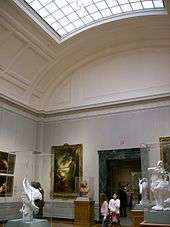
The Museum of Fine Arts holds one of the most comprehensive collections in the world, and possesses materials from a wide variety of art movements and cultures. The museum maintains one of the largest online databases in the world, with information on over 346,000 items from its collection, accompanied with digitized images.
Some highlights of the collection include:
- Egyptian artifacts including sculptures, sarcophagi, and jewelry
- French impressionist and post-impressionist works by artists such as Paul Gauguin, Manet, Renoir, Degas, Monet, Van Gogh, Cézanne
- 18th- and 19th-century American art, including many works by John Singleton Copley, Winslow Homer, John Singer Sargent, and Gilbert Stuart
- Chinese painting, calligraphy and imperial Chinese art, including some of the most treasured paintings in Chinese history
- The largest museum collection of Japanese works under one roof in the world outside Japan, including the Edward S. Morse collection of 5,000 pieces of Japanese pottery
- The Rothschild Collection - over 130 objects from the Austrian branch of the Rothschild family. Donated by Bettina Burr and other heirs[10]
The libraries at the Museum of Fine Arts house 320,000 items. The main branch, the William Morris Hunt Memorial Library, named after the noted American artist, is located off-site in Horticultural Hall.[11]
Highlights
Other notable works are in the collection, but the following examples are ones in the public domain and for which pictures are available.
American
 John Singleton Copley, Paul Revere, 1768
John Singleton Copley, Paul Revere, 1768.jpg) John Singleton Copley, Watson and the Shark, 1778
John Singleton Copley, Watson and the Shark, 1778 Gilbert Stuart, George Washington, 1796
Gilbert Stuart, George Washington, 1796 Washington Allston, Self-Portrait, 1805
Washington Allston, Self-Portrait, 1805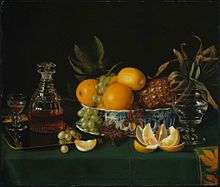 Charles Bird King, Still Life on a Green Table Cloth, 1815
Charles Bird King, Still Life on a Green Table Cloth, 1815 Fitz Henry Lane, Salem Harbor, 1853
Fitz Henry Lane, Salem Harbor, 1853 Martin Johnson Heade, Passion Flowers and Hummingbirds, c. 1870-1873
Martin Johnson Heade, Passion Flowers and Hummingbirds, c. 1870-1873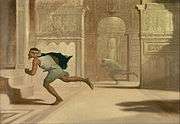 William Rimmer, Flight and Pursuit, 1872
William Rimmer, Flight and Pursuit, 1872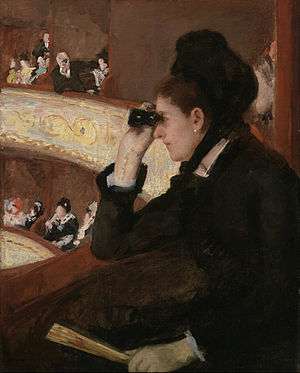 Mary Cassatt, In the Loge, 1878
Mary Cassatt, In the Loge, 1878 Mary Cassatt, Tea, 1880
Mary Cassatt, Tea, 1880.jpg)
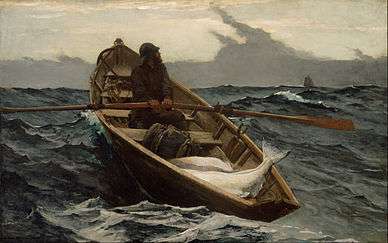 Winslow Homer, The Fog Warning, 1885
Winslow Homer, The Fog Warning, 1885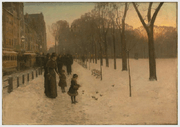 Childe Hassam, At Dusk (Boston Common at Twilight), 1886
Childe Hassam, At Dusk (Boston Common at Twilight), 1886_and_Her_Daughter_Rachel_-_Google_Art_Project.jpg)
European
_-_The_Dead_Christ_with_Angels_-_Google_Art_Project.jpg) Rosso Fiorentino, The Dead Christ with Angels, 1524-1527
Rosso Fiorentino, The Dead Christ with Angels, 1524-1527.jpg) Workshop of Pieter Bruegel the Elder, Combat between Carnival and Lent, 1525-1569
Workshop of Pieter Bruegel the Elder, Combat between Carnival and Lent, 1525-1569_-_Fray_Hortensio_F%C3%A9lix_Paravicino_-_Google_Art_Project.jpg) El Greco, Fray Hortensio Félix Paravicino, 1609
El Greco, Fray Hortensio Félix Paravicino, 1609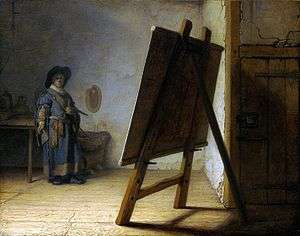
 Diego Velázquez, Don Baltasar Carlos with a Dwarf, 1632
Diego Velázquez, Don Baltasar Carlos with a Dwarf, 1632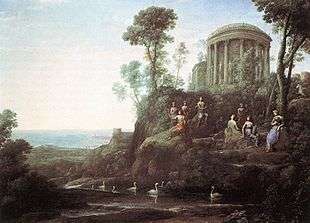 Claude Lorrain, Apollo and the Muses on Mount Helion, 1680
Claude Lorrain, Apollo and the Muses on Mount Helion, 1680 Giovanni Paolo Panini, Picture Gallery with Views of Modern Rome, 1757
Giovanni Paolo Panini, Picture Gallery with Views of Modern Rome, 1757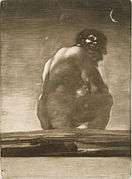 Francisco Goya, Seated Giant, 1818
Francisco Goya, Seated Giant, 1818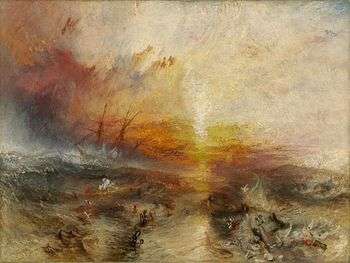 J.M.W. Turner, The Slave Ship 1840
J.M.W. Turner, The Slave Ship 1840
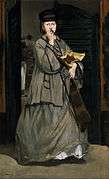 Edouard Manet, Street Singer, 1862
Edouard Manet, Street Singer, 1862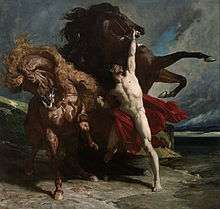 Henri Regnault, Automedon with the Horses of Achilles, 1868
Henri Regnault, Automedon with the Horses of Achilles, 1868 Edgar Degas, At the Races in the Countryside, 1869
Edgar Degas, At the Races in the Countryside, 1869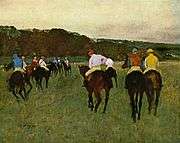 Edgar Degas, Racehorses at Longchamp, 1873–1875
Edgar Degas, Racehorses at Longchamp, 1873–1875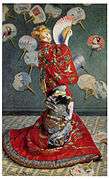 Claude Monet, La Japonaise, 1876
Claude Monet, La Japonaise, 1876 Paul Cézanne, Madame Cézanne in a Red Armchair, 1877
Paul Cézanne, Madame Cézanne in a Red Armchair, 1877 Auguste Renoir, Dance at Bougival, 1883
Auguste Renoir, Dance at Bougival, 1883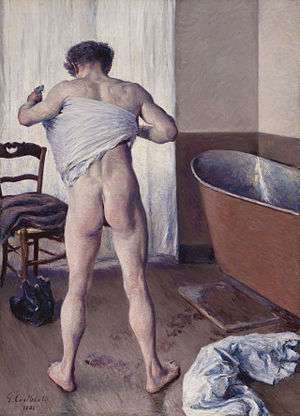
 Claude Monet, Poppy Field in a Hollow near Giverny, 1888
Claude Monet, Poppy Field in a Hollow near Giverny, 1888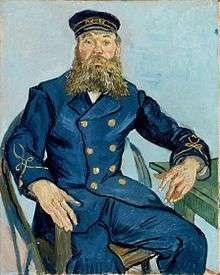 Vincent van Gogh, Postman Joseph Roulin, 1888
Vincent van Gogh, Postman Joseph Roulin, 1888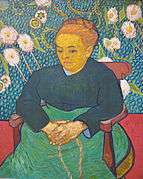 Vincent van Gogh, La Berceuse, 1889
Vincent van Gogh, La Berceuse, 1889
Antiquities
_and_queen.jpg) King Menkaura (Mycerinus) and queen, 2490–2472 BCE
King Menkaura (Mycerinus) and queen, 2490–2472 BCE- Winged Protective Deity, 883-859 BCE
.jpg) Goddess Tawaret, 623-595 BCE
Goddess Tawaret, 623-595 BCE_-_Google_Art_Project.jpg) Marine Mosaic, 200-230 CE
Marine Mosaic, 200-230 CE
Notable people
Directors
- Emil Otto Grundmann - first Director
- Edward Robinson - second Director
- Arthur Fairbanks - third Director
- Malcolm Rogers - tenth Director
- Matthew Teitelbaum - eleventh Director
Curators
- Sylvester Rosa Koehler - first Curator of Prints (1887-1900)
- Ernest Fenollosa - Curator of Oriental Art (1890–1896)
- Benjamin Ives Gilman - Curator (1893-1894?); Librarian (1893-1904); Secretary (1894-1925) Assistant Director, 1901-1903); Temporary Director (1907)
- Okakura Kakuzō - Curator of Oriental Art (1904–1913)
- Fitzroy Carrington - Curator of Prints (1912-1921)
- Ananda Coomaraswamy - Curator of Oriental Art (1917–1933)
- William George Constable - Curator of Paintings (1938-1957)
- Cornelius Clarkson Vermeule III - Curator of Classical Art (1957-1996)
- Jonathan Leo Fairbanks - Curator of American Decorative Arts and Sculpture (1970–1999)
- Theodore Stebbins - Curator of American Paintings (1977–1999)
- Anne Poulet - Curator of Sculpture and Decorative Arts (1979–1999)
See also
References
- ↑ "Museum of Fine Arts Annual Report". Museum of Fine Arts. Retrieved 20 May 2016.
- ↑ Natasha. "John Singer Sargent Virtual Gallery". Jssgallery.org. Retrieved 2012-12-17.
- ↑ "An announcement was made..." (hathitrust.org). The Brickbuilder. Boston, MA: Rodgers & Manson. 8 (12): 237. December 1899. Retrieved 7 March 2015.
- ↑ "Architectural History - Museum of Fine Arts, Boston". Museum of Fine Arts, Boston. Retrieved March 4, 2012.
- ↑ Dobrzynski, Judith H. (10 November 2010). "Boston Museum Grows by Casting a Wide Net". The New York Times. Retrieved 14 May 2016.
- ↑ Judith H. Dobrzynski (March 14, 2012), "How an Acquisition Fund Burnishes Reputations". The New York Times.
- ↑ "Lime Green Icicle Tower". Museum of Fine Arts. Retrieved October 26, 2014.
- ↑ "Japanese Garden, Tenshin-en". Boston Museum of Fine Arts. Retrieved 16 August 2015.
- ↑ Takes, Joanna Werch (January 20, 2015). "Chris Hall: A (Japanese-Inspired) Timber Framing Philosophy for Furniture". Woodworker's Journal. Retrieved 16 August 2015.
- ↑ "Museum of Fine Arts, Boston, Announces Major Gift from Rothschild Heirs, Including Family Treasures Recovered from Austria after WWII." Museum of Fine Arts, Boston. 22 February 2015. Retrieved 3 March 2015.
- ↑ "The William Morris Hunt Memorial Library, Museum of Fine Arts, Boston". Mfa.org. Retrieved 2012-12-17.
External links
| Wikimedia Commons has media related to Museum of Fine Arts, Boston. |
Coordinates: 42°20′21″N 71°05′39″W / 42.33917°N 71.09417°W
